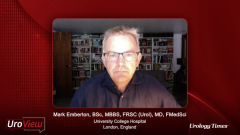
Available Focal Therapy Options for Localized Prostate Cancer
An in-depth discussion of emerging focal therapy options for clinically localized prostate cancer.
Episodes in this series

Mark Emberton, BSc, MBBS, FRSC (Urol), MD, FMedSci: So the aim of focal therapy is a selective destruction of the cancer plus a margin and preservation of the critical structures within the prostate, so as not to confer toxicity. And by toxicity, we mean incontinence and sexual dysfunction in the broadest sense. There are a large number of energy sources available and an increasing number of energy sources available to do that, but the aim is the important bit. At present, the selectivity achieved, in other words, you treat the cancer, but- and preserve normal tissue is a spatially selective selectivity. So in other words it's the operator putting the energy source that causes the tissue to die or the cells to commit suicide in the area around the cancer, but nowhere else. So in other words, the cell selectivity doesn't come from any biological attribute of the cancer. So we're not using an antibody that treats cancer cells more than benign cells. We're not using chemotherapy that is more likely to make a cancer cell die than a normal cell, etc. We are using a spatially selective mode of destruction. And historically the treatments has really exploited the extremes of temperature to achieve coagulative necrosis, in the same way, that one can cook meat. And you see the proteins degrade. If you-chicken goes from pink to white, and the white is the degeneration of the protein. And the other extreme obviously is Cryotherapy, which has been around for also 100 years, which goes to very, very low- temperature levels minus 40, times two. And the transition of going from room temperature to minus 40 back to room temperature to minus 40, is highly destructive to the cells within the ice ball. And so, Cryotherapy is probably the oldest technology and was probably the first focal therapy done. That was soon superseded by high-intensity focused ultrasound, which basically concentrates sound energy into the prostate, in the same way, that one would concentrate light energy with a magnifying glass. And we all did this as children. And if you use that much light energy in your magnifying glass but focus on the point that goes bright on the poor little insect or your friend's back of the hand, you soon learn that you can achieve a very quick and painful burn by focusing. But if you defocus or pass your finger between the magnifying glass and the very bright point, nothing happens. And high-intensity focused ultrasound does just that. So, it concentrates 30 to 40 Watts per square centimeter of energy, to about 1500 Watts per square centimeter energy. So, it concentrates energy hugely. So, you can spot well the tumor, with extraordinary precision. Since the emergence of ultrasound of high intensity-focused ultrasound, there have been some other technologies, and they've largely been used light. So, this is called photodynamic therapy. And so, you give an injection which photos sensitizes the whole body. And then you expose the bit that you are after to light. And we did a phase one, phase two, and phase three study, using that technology. And you can achieve selective destruction of that. And that's largely by the release of free radicals. All these treatments work in a slightly different manner. And all these treatments have to obey the laws of physics. And all these treatments require a dedicated amount of expertise to make them work well, as well as all the risk stratification precision that we talked about earlier. I suppose, the new focal therapies that are, if you look at the stuff in clinical trials at present focal therapies that involve nanoparticles, which will selectively collect in the tumor, and then some method of initiating the toxic payload associated with those nanoparticles, whether that be by light or through magnetism, or indeed through ultrasound. So, there are a lot of complex interventions, that involve injection and some mode of initiating. But none of those are in the clinical use of present and are in various phases of evaluation.
Newsletter
Stay current with the latest urology news and practice-changing insights — sign up now for the essential updates every urologist needs.



















